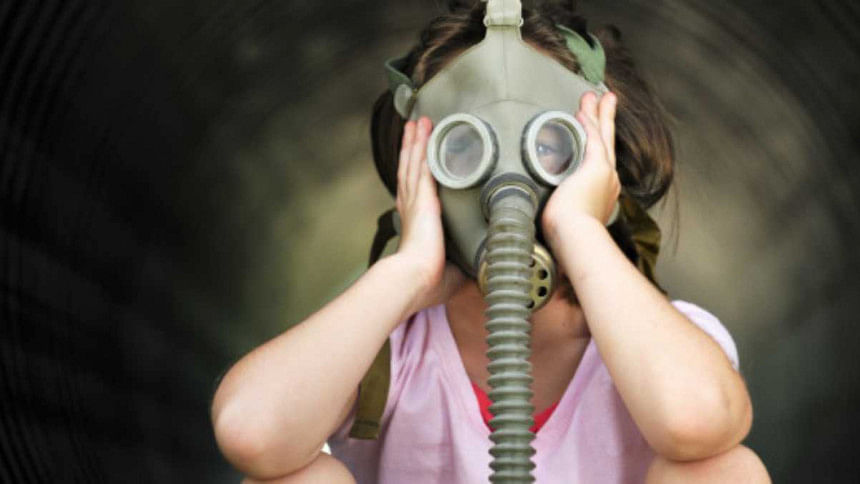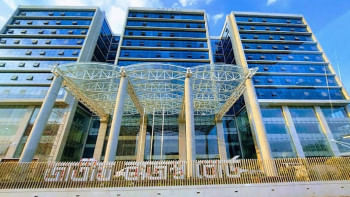Pollution plays havoc with children's health!

Thanks to the World Health Organisation (WHO), we now have a clearer picture of what indoor and outdoor pollution is doing to our children's health. Let's take a look at the facts. 280,000 children (under 5) die in Bangladesh annually due to pollution. Worldwide the number of child casualties is 17 lakh. That means nearly 17 percent of all children dying due to pollution are Bangladeshi. How did we get here? It didn't happen in a day, but it also didn't take 100 years. Two reports by WHO, 'Inheriting a Sustainable World: Atlas on Children's Health and the Environment' and 'Don't pollute My Future', unveiled recently shed light on the gloomy subject. And it's not just the WHO reports that are raising alarm bells on the adverse effects of pollution on children's health. According to a report published on March 7 in this paper, Professor Abul Kalam Azad, director general of Health Services said, "In Bangladesh, the level of outdoor air pollution is high because of construction work and increasing number of vehicles. Besides, use of fossil fuel contributes to indoor air pollution."
The most common causes of death for children under 5 in the country are: diarrhoea, malaria and pneumonia — all preventable deaths that can be mitigated by reducing environmental risks, i.e. by increasing better access to safe drinking water and cooking fuels. Now, the typical response from the government would be that it is doing the best it can given the difficult circumstances which rapid urbanisation brings. But is that truly the case? Is enough being done to stop the wholesale destruction of the major rivers that feed the capital city and beyond? Is it not a fact that the authorities have failed miserably to tackle the Hazaribagh relocation since 2009 (that's when the ruling party came to power)? Is it not a fact that despite numerous reports, both by government bodies and international organisations, we chose to ignore the health hazards of untreated toxins being dumped into the Buriganga river (which happens to supply the bulk of Dhaka city's water supply) with the excuse that the tannery industry is an emerging export sector, one with the potential to become the next RMG-like miracle? Are we not now witnessing the destruction of yet another major river, the Dhaleshwari thanks to our pathetic lack of planning with regards to faulty design of the CETP (central effluent treatment plant) that has no de-salinisation component to render useless the tonnes of salt used in the tanning process at Savar tannery zone?
Let us move on to other major polluting agents. Bangladesh, Dhaka in particular, has been undergoing major infrastructure development for the last few years. There is heavy duty construction of flyovers and an ever increasing number of vehicles in a city that suffers hours and hours of traffic gridlock. The capital city is ringed by a host of traditional brick kilns that spew out black smoke where low-grade coal is the primary source of fuel. Air pollution in Dhaka has gone through the roof thanks primarily to weak regulatory bodies that are understaffed and prone to graft, allowing for wholesale pollution of the air.
The effect of such a relaxed outlook towards pollution is taking its toll on children whose immune systems are simply not designed to cope with such high levels of toxicity in the air. When we couple that with household air pollution, we can begin to comprehend why Bangladeshi children are dying by the hundreds of thousands. According to media reports, 89 percent of households use solid fuels, mostly wood, agricultural waste and cow manure for cooking and space heating. As per a UNICEF report titled "Clear the air for children: The impact of air pollution on children", Bangladesh has one of the highest rates of child mortality in the world.
The government has a strategy called 'Country Action Plan for Clean Cookstoves' that aims to achieve 100 percent clean cooking solutions by 2030. Under the plan, it intends to distribute improved stoves to more than 30 million households by 2030 -- a noble aim that could be achieved if it took help from non-state actors like non-government organisations and print/electronic media in long-term, sustained nationwide awareness campaigns that could effectively tackle lack of awareness of health hazards.
At the end of the day, we should remember indoor pollution affects not only children's developing lungs but have the potential to permanently damage their brains. With that knowledge, it is time to give equal importance to mitigating indoor pollution as mitigating outdoor pollution is a much greater challenge for the government. Before we start talking about retrofitting brick kilns, we should be talking about making watchdog bodies effective and free of graft. Before we start blaming tannery industries, we should be going back to the drawing board and finding out why shoddy planning failed to take into account the de-salinisation in an effluent treatment plant for a tannery zone. It is time to take responsibility for a lack of planning and implementation of existing laws that are there to protect public interest, and as in this case, public health. Today's healthy child is tomorrow's healthy adult. A fit adult, sound of body and mind, is an asset to the nation. A sick adult is a burden for the state. Simple really!
The writer is Assistant Editor, The Daily Star.

 For all latest news, follow The Daily Star's Google News channel.
For all latest news, follow The Daily Star's Google News channel. 



Comments